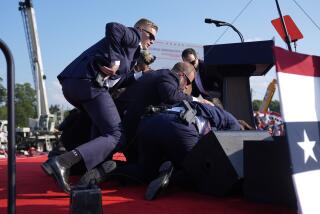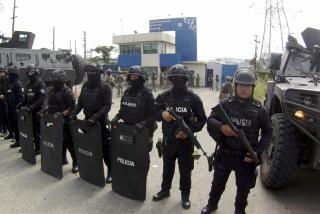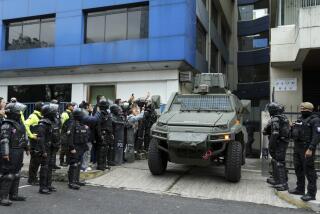Embassies in Africa Lack State-of-the-Art Security
WASHINGTON — The U.S. government has spent more than $1 billion to turn about 20 of its embassies around the world into state-of-the-art anti-terrorist fortresses, designed to withstand mob violence and car bombs.
The buildings in Nairobi and Dar es Salaam are not among them.
State Department officials said that, until Friday’s deadly bombings in Kenya and Tanzania, neither country was on the department’s list of high-danger posts.
Even in hindsight, one official said, it would be hard to justify additional security for either embassy because massive acts of terrorism have been extremely uncommon in most of Africa.
In 1985, two years after suicide bombers destroyed embassies in Beirut and Kuwait City, the Reagan administration announced an ambitious $3.5-billion program to relocate or rebuild almost half of the 262 embassies and consulates around the world to make them impervious to attack.
But Congress never approved the full appropriation sought by President Reagan, and the security upgrade eventually bogged down after new embassies were opened in such high-risk countries as Egypt, Lebanon, Saudi Arabia, Colombia, Peru and a handful of others.
A fortified mission was opened in El Salvador just before the end of the civil war that had made the country a hazardous assignment for U.S. diplomats.
The program was controversial from the start: Critics complained that the security-conscious embassies were forbidding to foreign residents and that the precautions prevented U.S. diplomats from coming in contact with the citizens of the countries they were supposed to be observing. Many of the high-security embassies were built in remote suburbs.
The security upgrade program was recommended by a high-level commission headed by Bobby Ray Inman, a retired admiral and a former deputy chief of the CIA.
The panel painted an extremely gloomy picture of diplomatic security, arguing that 126 embassies and consulates were unsafe and calling for total reconstruction of 75 posts.
In a telephone interview Friday, Inman said his panel stressed the importance of moving promptly to upgrade diplomatic security because “you are not likely to get advance warning” of an attack.
He said the commission considered criticism that it wanted to turn embassies into fortresses but determined that “Americans should never be held hostage to terrorists, and Americans working for the government deserve protection.”
“Embassies should never be in buildings with a connecting wall to another building,” he said. “The building should be at least 75 feet from the street.”
Congress initially hailed the report, but less than a year later lawmakers were complaining, with then-Senate Foreign Relations Chairman Richard G. Lugar (R-Ind.) accusing the State Department of trying to “gold plate” its embassies.
Despite the urging of then-Secretary of State George P. Shultz, the lawmakers supplied less than half of the money the Inman commission had recommended.
On Friday, members of Congress complained that security was dangerously lax in U.S. embassies in Africa and demanded that the administration do something about it.
Rep. Benjamin A. Gilman (R-N.Y.), chairman of the House International Relations Committee, said the bombing “underscores the need for beefing up security in all of our embassies, and we haven’t done enough, regrettably, in our African embassies. All necessary measures are going to have to be undertaken immediately by our State Department, by our security people, and other agencies to protect all Americans and our personnel and facilities in the region.”
Rep. Christopher H. Smith (R-N.J.), chairman of the International Operations and Human Rights Subcommittee, agreed: “As my subcommittee continues to look into the bombings, we will make certain that embassy security remains a high priority and that our State Department receives the resources it needs to minimize the possibility that further tragedies of this sort will happen in the future.”
Nevertheless, State Department officials said that it probably would be a mistake to mount a crash program to bring all embassies up to “Inman standards,” especially in places without much history of terrorist action against Americans.
At the same time, officials acknowledged that fortresslike security sometimes makes a difference.
In Saudi Arabia, where the embassy is one of the most secure in the world, terrorists have twice attacked U.S. military facilities, including the Khobar Towers housing complex, while not taking on the embassy, which appears to be a much harder target.
However, critics say the increased security makes it far more difficult for diplomats to do their jobs.
For instance, diplomatic observers say, after the Portuguese revolution in 1974, the staff of the U.S. Embassy--located in the center of Lisbon with minimal security--led by Ambassador Frank C. Carlucci and Political Officer Charles Thomas, won high praise for keeping in touch with a host of new political movements and the leaps and twists of public opinion.
In the 1980s, however, the U.S. moved the embassy to an isolated hill on the outskirts of Lisbon.
Diplomats assigned to the new embassy complained about the difficulty of taking the pulse of Lisbon.
Without this contact with the city’s daily life, they said, they had to struggle to understand Portugal and the Portuguese.
UNLIKELY TARGETS: Kenya and Tanzania seem to be very unlikely targets for terrorist attacks. A15
PHOTOS, GRAPHICS, A14-15
(BEGIN TEXT OF INFOBOX / INFOGRAPHIC)
Securing An Embassy (A16)
In the wake of the 1984 car bombing of the U.S. Embassy in Lebanon, many American embassies around the world have become fortresses. Successive layers of security are ultimately intended to protect a critical core, giving embassy staffers enough time to destroy sensitive documents before they fall into terrorist hands.
Restricted Entry
Guard Booths: Bulletproof shelters for armed guards
Perimeter walls: Reinforced concrete, anchored to foundation
Steel spikes create “mob-resistant” walls
Slit windows Bulletproof; coated with anti-blast glaze; windows don’t open
Special roof designed to conceal sharpshooters
Maximum security “safe haven” Specially reinforced area of building protects embassy personnel from forced entry for up to 60 minutes from incursion
Source: Los Angeles Times research
More to Read
Sign up for Essential California
The most important California stories and recommendations in your inbox every morning.
You may occasionally receive promotional content from the Los Angeles Times.










